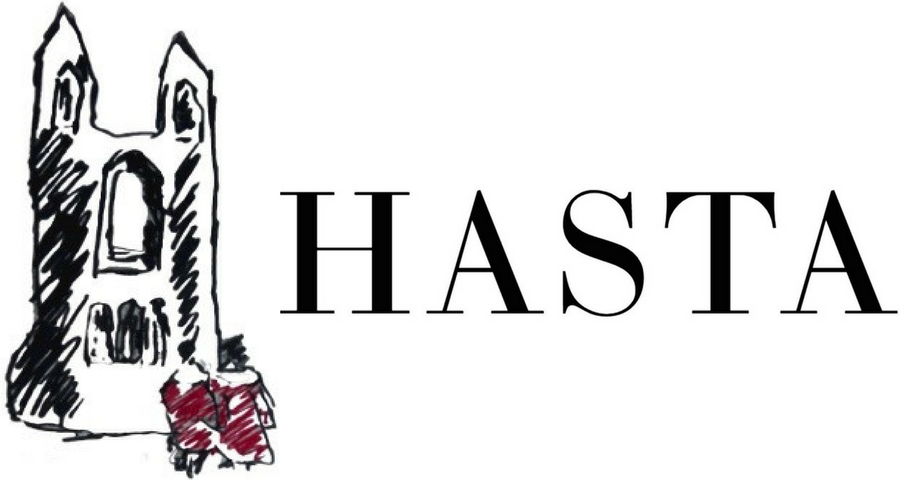Young Contemporary Artists: Max Martyns
By Lily Spencer
Walking into an ochre-yellow living room in Hackney, East London, I am confronted by an enormous swirl of black, white and grey, standing on the back of an armchair, leaning against the wall. This is the living room of the twenty-one-year-old artist, Max Martyns. Specialising in large-scale abstract gestural painting, he works mainly in monochrome, but has recently branched into colour, reds in particular. Born and bred in this house, he did not go far for art college, graduating from the Slade – part of University College London - just this summer.
Max Martyns, 1995-
During his foundation degree he largely created found-object sculpture, mainly because of the size of the space and materials available to him. He started small, creating balancing sculptures, but this experimentation culminated in a cage-like sculptural installation made of paint palettes. In this, one can see the roots of his more recent work in his bending of the definition of medium and material. In his foundation degree he turned a sculpture into an installation; for his final degree show he made an installation out of his painting. He painted an 11.5m long canvas, and then displayed it in a three-walled structure so that the viewer would be completely surrounded by the work. Its horizontal orientation, reinforced by the brush strokes, pulls you through the chaos from one end to the other.
It is this type of intensely psychological painting that Martyns is interested in. His work is dominating in size and dynamic in gesture. The black, white and grey dart about the canvases with a force and confidence that could only come from an artist truly at ease with his medium.
His favourite work is Ink 98, (2017), which is what he calls a ‘transitional area painting.’ Instead of creating a work that draws the viewer in, grabbing their full attention, the aim is to be perceived only in one’s peripheral vision. He uses his characteristically vigorous brush strokes that move from black to white and back again, which is disjointed by an abrupt rectangle that has a much more smooth and calm surface. On the far right, after this rectangle, a deep red peeks through the brush strokes. Unlike Ink 100, (2017), which captures the viewer in its movement, Ink 98, with its more gentle left-to-right orientation, pushes you along the corridor. Areas of calm are dispersed among the chaos. For his degree show it was placed in the hallway before you reached his central piece. It smoothed your progression towards Ink 100, preparing your eye and pulling you along the corridor, before you reached the monumental snake of a painting.
Max Martyns, Ink 98, 2017, ink and house paint on canvas, 220x90cm.
Image source: Max Martyns
Talking about Ink 98, Martyns says, ‘it is kind of like a window… [when] you get a new apartment, you have a window and it’s got a lovely view... you look out of it for the first two weeks that you live there and then after those two weeks you kind of just walk past it, and you catch it in your peripheral vision, but it still affects the way that you’re thinking.’
Regarding its placement in the exhibition in conjunction with Ink 100 he says, ‘it’s just about trying to understand space, and how you can […] manipulate a space and manipulate a person in a space, without shoving it in their face and telling them that you’re doing it.’
Martyns’s interest in space comes from the principles that first drew him to painting; what he calls ‘the basics of painting.’ He told me that ‘I just got to college and thought, well I could just do found-object sculpture, which is what I’ve been doing all through my Foundation or I could just go, alright, I’ll do something I don’t know how to do, see if I can master it by the time I’m done here.’ He chose painting – ‘I’ve always seen painting as a challenge and thought, “Oh, I can’t paint,” so I just thought, “fuck it, let’s learn to paint.’ So he taught himself to paint, starting from the basics.
“The basics of painting come down to material, mark-making, composition and… space.”
Max Martyns, Ink 81, 2016, ink and house paint on canvas 200x120cm.
Image source: Max Martyns
He spent his time at the Slade doing mark-making studies and experimenting with composition, often being criticised by his tutors for not developing or changing quickly enough. His response to this, however, was that it was a slow process; his work was changing, but only where it needed to in order to better his skills and to better understand his medium. “In my eyes the small changes are changes, and just because you don’t notice them doesn’t mean my art’s not changing.” In order to master the medium, fully develop his style and create a complete, dynamic and interesting piece for his final degree show, he slowly mastered each element in isolation and put them all together for the final piece, Ink 100.
In the future, Martyns hopes to keep London as his base, being a ‘born and bred Londoner’, but he is interested in looking abroad from an artistic and marketing perspective. He is possibly looking to sell work in Dubai and other areas of the Arabian Peninsula, as well as explore his interests in Chinese ink paintings, calligraphy and calligraphic masters.
Max's Website: https://www.maxmartyns.com/
Follow Max on Instagram: https://www.instagram.com/maxmartyns/
Follow Max on Facebook: https://www.facebook.com/maxmartyns/





